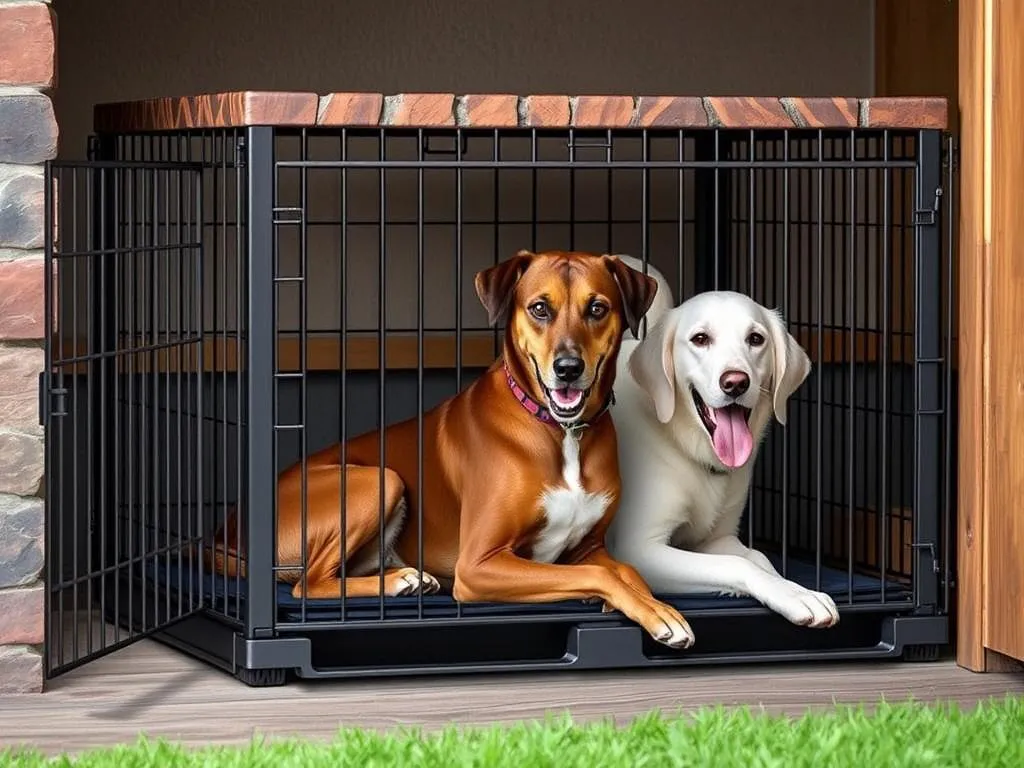
Dog crates are an essential tool for pet owners, providing a safe and secure environment for our furry friends. They serve multiple purposes, from aiding in house training to offering a cozy retreat during travel. With numerous options available in the market, selecting the best dog crate tailored to your pet’s needs can feel overwhelming. This guide aims to simplify that decision, helping you understand the various types of crates, the factors to consider, and the features that will enhance your dog’s comfort and safety.
Understanding Dog Crates
What is a Dog Crate?
A dog crate is essentially a confined space that mimics a den, providing your pet with a personal area to feel safe and secure. The primary purpose of a crate is to keep your dog contained and safe while ensuring they have a comfortable space to relax. Common uses include:
- Training: Crates can be a valuable tool for house training, teaching dogs where they can go and what is acceptable behavior.
- Travel: Many pet owners utilize crates to transport their dogs safely in vehicles.
- Safety: Crates can prevent dogs from getting into harmful situations when unsupervised.
- Comfort: A crate can act as a sanctuary for dogs, allowing them to retreat when they feel overwhelmed.
Benefits of Using a Dog Crate
Using a dog crate offers numerous benefits, including:
- Safe Space: Provides a designated, safe area for your dog.
- House Training Aid: Assists in house training by encouraging dogs to hold their bladder.
- Anxiety Reduction: Creates a secure environment, helping to alleviate anxiety during stressful situations.
- Travel Convenience: Makes traveling with pets easier and safer.
Types of Dog Crates
Choosing the right type of crate is crucial. Here are the most common types:
- Wire Crates: Made from metal, these crates are sturdy and provide excellent ventilation.
- Plastic Crates: Ideal for travel, these lightweight crates are more enclosed, providing a den-like feel.
- Soft-sided Crates: Often used for travel, these fabric crates are lightweight and easy to transport but may not suit every dog.
- Heavy-duty Crates: Designed for strong or destructive dogs, these crates are built to withstand chewing and escape attempts.
- Customizable Crates: Some crates come with features that allow you to adjust their size, perfect for growing puppies.
Factors to Consider When Choosing a Dog Crate
Size of the Dog
Choosing the right size crate is critical. Measure your dog’s height and length to select an appropriate size. The crate should be large enough for your dog to stand up, turn around, and lie down comfortably. Keep in mind that puppies will need room to grow, so consider a crate with adjustable dividers.
Dog Behavior and Temperament
Understanding your dog’s behavior can influence your choice of crate. If your dog is anxious or tends to chew, consider a heavy-duty or escape-proof crate. For calmer dogs, a wire or soft-sided crate may suffice. Training techniques can also vary, so ensure you choose a crate that suits your dog’s temperament.
Purpose of the Crate
Consider the primary use of the crate. Will it be used for travel, training, or as a permanent fixture in your home? For travel, a lightweight and portable option may be best, while a durable, heavy-duty crate might be better for home use.
Material and Durability
Different materials offer various benefits. Wire crates are breathable and easy to clean, while plastic crates provide more privacy. Soft-sided crates are lightweight, but they may not be suitable for dogs that chew or scratch. Assess the pros and cons of each material based on your dog’s breed and behavior.
Top Features to Look For
Ventilation and Visibility
Good airflow and visibility are essential for your dog’s comfort. Look for crates that provide adequate ventilation to keep your pet cool and allowed sightlines to feel secure.
Ease of Cleaning
Dogs can be messy, so choose a crate with removable trays or washable materials. This feature will save you time and ensure your crate remains hygienic.
Portability
If you plan to travel with your dog, consider the weight and portability of the crate. Lightweight options are easier to transport, while heavy-duty models may offer sturdiness but can be cumbersome.
Security Features
Ensure the crate has a reliable latch system. Escape-proof designs are particularly important for dogs that are prone to trying to get out.
Safety Features
Safety should always be a priority. Look for crates with rounded corners, non-toxic materials, and chew-proof options to protect your dog from injury.
Reviews of the Best Dog Crates
Best Dog Crates for Small Dogs
- Petmate Two Door Top Load Kennel
- Pros: Convenient top-loading feature, great for anxious dogs.
-
Cons: Limited ventilation compared to wire crates.
-
MidWest Life Stages Folding Metal Dog Crate
- Pros: Adjustable divider for growing puppies, easy to clean.
- Cons: More expensive than plastic alternatives.
Best Dog Crates for Medium Dogs
- Frisco Heavy Duty Double Door Dog Crate
- Pros: Sturdy and escape-proof, dual entry points.
-
Cons: Might be too large for some spaces.
-
PetFusion BetterBox Dog Crate
- Pros: Modern design, easy to assemble, and clean.
- Cons: Pricier than standard wire crates.
Best Dog Crates for Large Dogs
- ProSelect Empire Dog Crate
- Pros: Extremely durable, escape-proof design.
-
Cons: Heavier and less portable.
-
EliteField 3-Door Folding Soft Dog Crate
- Pros: Lightweight and portable, great for travel.
- Cons: May not withstand heavy chewing.
Best Budget-Friendly Dog Crates
- AmazonBasics Folding Metal Dog Crate
- Pros: Affordable, easy to assemble.
-
Cons: Lacks some advanced safety features.
-
Paws & Pals Dog Crate
- Pros: Lightweight and portable, good for budget-conscious buyers.
- Cons: Less durable than pricier options.
Best High-End Dog Crates
- Diggs Revol Dog Crate
- Pros: Stylish, easy to transport, and collapsible.
-
Cons: High price point.
-
Petmate Sky Kennel
- Pros: Airline approved, durable and secure.
- Cons: Heavier than other models.
How to Train Your Dog to Use a Crate
Introduction to Crate Training
Crate training is an effective method for helping your dog understand their space. It provides comfort and security, making it an excellent tool for house training and reducing anxiety.
Step-by-Step Crate Training Techniques
- Gradual Introduction: Start by allowing your dog to explore the crate without pressure. Leave the door open and encourage them to enter.
- Positive Reinforcement: Reward your dog with treats and praise when they enter the crate willingly. This encourages positive associations.
- Short Stays: Initially, keep your dog in the crate for short periods, gradually increasing the time as they become more comfortable.
- Dealing with Resistance: If your dog shows resistance, don’t force them. Instead, create a positive environment with toys and treats.
Common Mistakes to Avoid
- Over-crating: Avoid leaving your dog in the crate for extended periods, as this can lead to anxiety or behavioral issues.
- Misunderstanding Needs: Be aware of your dog’s needs for space and comfort. Not every dog will adapt to crate training in the same way.
Frequently Asked Questions (FAQs)
How long can a dog stay in a crate?
Generally, adult dogs can stay in a crate for 4-6 hours, while puppies may need to be let out every 2-3 hours. Always consider your dog’s needs and comfort.
Can I use a crate for puppy training?
Yes, a crate can be an effective tool in puppy training, helping to establish boundaries and encourage house training.
What is the best crate for a growing puppy?
A crate with an adjustable divider is ideal for growing puppies, allowing you to modify the space as they grow.
How do I choose the right size crate for my dog?
Measure your dog from nose to tail and height while standing. The crate should be large enough for your dog to stand, turn around, and lie down comfortably.
Are there any specific brands recommended for dog crates?
Brands like MidWest, Petmate, and Diggs are often recommended for their quality and reliability.
Conclusion
Choosing the best dog crate involves considering your dog’s size, behavior, and the intended use of the crate. From understanding the various types to identifying essential features, selecting the right crate can significantly enhance your dog’s comfort and safety. Investing in a quality crate not only benefits your pet but also contributes to a harmonious household. Remember, a well-chosen crate can become a beloved sanctuary for your furry companion.









